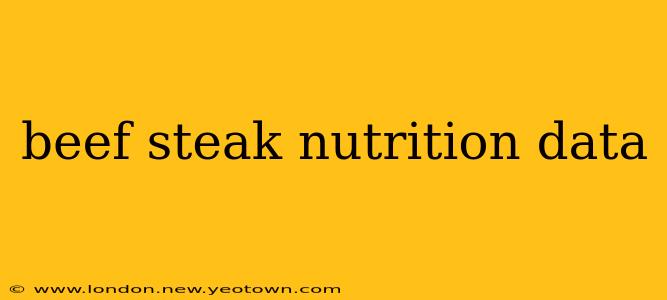The aroma of a perfectly seared beef steak, sizzling on the grill, is enough to make anyone's mouth water. But beyond its deliciousness, beef steak offers a surprisingly robust nutritional profile. However, understanding its nutritional data requires a nuanced perspective, acknowledging both its benefits and potential drawbacks. This deep dive into beef steak nutrition will arm you with the knowledge to make informed dietary choices.
What are the Nutritional Benefits of Beef Steak?
Let's start with the good stuff. Beef steak is a fantastic source of high-quality protein, crucial for building and repairing tissues, making it a staple for athletes and those seeking muscle growth. A 3-ounce serving can provide around 20-25 grams of protein, contributing significantly to your daily needs. Beyond protein, beef is rich in iron, vital for oxygen transport throughout the body. Iron deficiency can lead to fatigue and weakness, so incorporating beef into your diet can be particularly beneficial for those at risk. It also provides essential B vitamins, such as vitamin B12, crucial for nerve function and red blood cell production. Furthermore, beef steak contains zinc, which supports immune function and wound healing, and selenium, an antioxidant that protects cells from damage. Finally, it provides a good source of creatine, important for muscle function and energy production.
How Much Fat and Cholesterol is in Beef Steak?
This is where the conversation gets a bit more complex. Beef steak, particularly richer cuts, is known for its fat content. The amount varies significantly depending on the cut (ribeye versus sirloin, for example), the marbling (the intramuscular fat), and the preparation method. While some fat is essential for nutrient absorption and hormone production, excessive fat intake can contribute to weight gain and increase the risk of heart disease. The cholesterol content is another consideration. Beef is relatively high in cholesterol compared to other protein sources; however, the impact of dietary cholesterol on blood cholesterol levels is currently debated among health professionals.
Is Beef Steak High in Calories?
Yes, beef steak can be relatively high in calories, particularly fatty cuts. The calorie count per serving can range from 150 to 300 or more, depending on the cut and preparation method. It's crucial to be mindful of portion sizes and cooking methods to manage calorie intake. Grilling or broiling, rather than frying, can significantly reduce added fat and calories.
What are the different types of beef steak and how does their nutrition vary?
The nutritional content of beef steak varies considerably depending on the cut. Leaner cuts like sirloin and tenderloin generally have fewer calories and less fat compared to richer cuts like ribeye and New York strip. The marbling—the distribution of fat within the muscle—is a key indicator of fat content. More marbling means more fat and calories. It's best to check the nutrition label or consult online resources for specific nutritional information per cut.
What are the health risks associated with eating too much beef steak?
Consuming excessive amounts of beef steak can contribute to several health risks. High saturated fat intake can increase the risk of heart disease. High cholesterol intake, while still debated, is linked to elevated blood cholesterol levels in some individuals. Furthermore, overconsumption of red meat has been associated with an increased risk of certain cancers. Moderation is key when incorporating beef steak into a balanced diet.
Are there any alternatives to beef steak that provide similar nutritional benefits?
While beef steak offers unique nutritional benefits, several alternatives provide similar advantages. Lean poultry, fish (especially fatty fish like salmon for omega-3s), beans, lentils, and tofu are excellent sources of protein and essential nutrients. These alternatives often have lower fat and calorie content compared to beef steak. A varied and balanced diet incorporating a range of protein sources is recommended.
How can I prepare beef steak in a healthy way?
Preparing beef steak healthily involves mindful choices. Opt for leaner cuts, trim excess fat before cooking, and choose healthy cooking methods like grilling, broiling, or baking. Avoid frying, which adds significant amounts of unhealthy fats. Controlling portion sizes is crucial for managing calorie and fat intake. Consider incorporating plenty of vegetables with your steak to create a more balanced and nutritious meal.
In conclusion, beef steak, enjoyed in moderation as part of a balanced diet, can be a valuable source of protein, iron, and other essential nutrients. However, awareness of its fat and cholesterol content is crucial for maintaining good health. Choosing lean cuts, employing healthy cooking methods, and controlling portion sizes are key to reaping the nutritional benefits without compromising your well-being.

